
Anatomy of a Project: The behind the scenes on trying to find and organize a Thunderbean title.
 I’m very happy to have had a little time to get back to working on some Thunderbean projects. There’s many hard drive surrounding my work area at this point, all with various pieces of various projects. In the next few weeks, I’m hoping to wrap quite a few projects that are close. No less than seven of the ‘special’ sets have everything scanned, and three ‘official’ sets are getting close at this point.
I’m very happy to have had a little time to get back to working on some Thunderbean projects. There’s many hard drive surrounding my work area at this point, all with various pieces of various projects. In the next few weeks, I’m hoping to wrap quite a few projects that are close. No less than seven of the ‘special’ sets have everything scanned, and three ‘official’ sets are getting close at this point.
I thought I’d write a little this week about the basic stages of producing a Thunderbean title, using the Flip the Frog Blu-ray set as an example. It’s been a long and overall fun journey on this project. I’ve gone over some of this a little before, but I thought it might be fin to show how the process went all together.
The Flip set has been in progress the second longest of any of the current titles. We started Flip in 2014. The longest dates back to 2011, and currently has 93 different films scanned for it (more on that project sometime soon). There’s been set backs, delays, and generally too many things that prevented ol’ Flip from getting closer to the finish line. I need to take the blame for this more than any one else, but I’m happy to have waited since so many other cool things have shown up in better quality since.
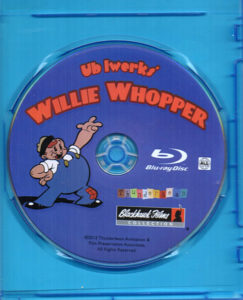 One of the biggest interrupters was Flip’s old friend Willie Whopper, and the full time production on that set in 2014 and 2015. I switched gears to work on that set more out of necessity, since a small window opened up with so many things lining up, not the least of them being David Shepard managing to acquire the rights for the films from the series that hd been sold to Modern Sound Pictures in the early 60s. I don’t regret the decision at all for lots of reasons, but Flip wasn’t too happy. He looked directly at us from the screen and, while clenching his fists, said ‘Damn!’.
One of the biggest interrupters was Flip’s old friend Willie Whopper, and the full time production on that set in 2014 and 2015. I switched gears to work on that set more out of necessity, since a small window opened up with so many things lining up, not the least of them being David Shepard managing to acquire the rights for the films from the series that hd been sold to Modern Sound Pictures in the early 60s. I don’t regret the decision at all for lots of reasons, but Flip wasn’t too happy. He looked directly at us from the screen and, while clenching his fists, said ‘Damn!’.
An early (and often ongoing) stage on any of these projects is to figure out where the ‘bodies are buried’ as it were. Early on on this title, I had a lot of conversions with David Shepard of Film Preservation Associates. David remembered when the material was transferred from Blackhawk Films to UCLA, and, amazingly, often remembered what existed on each individual title! This information turned out to be invaluable since we were looking for the best on each film. David had made sure many of the titles were preserved when the nitrate started to deteriorate, and this saved many of the titles. In most cases, happily, the nitrate was in excellent shape, although there were of course issues with some of the material, as to be expected.
The project *really* owes a big part of its existence to Dave Gerstein. He is dedicated to Flip on a cellular level, and has been invaluable in helping. One of the first things he did was provide me with a page of chronological title sequences. This came in incredibly handy when looking at the master material.
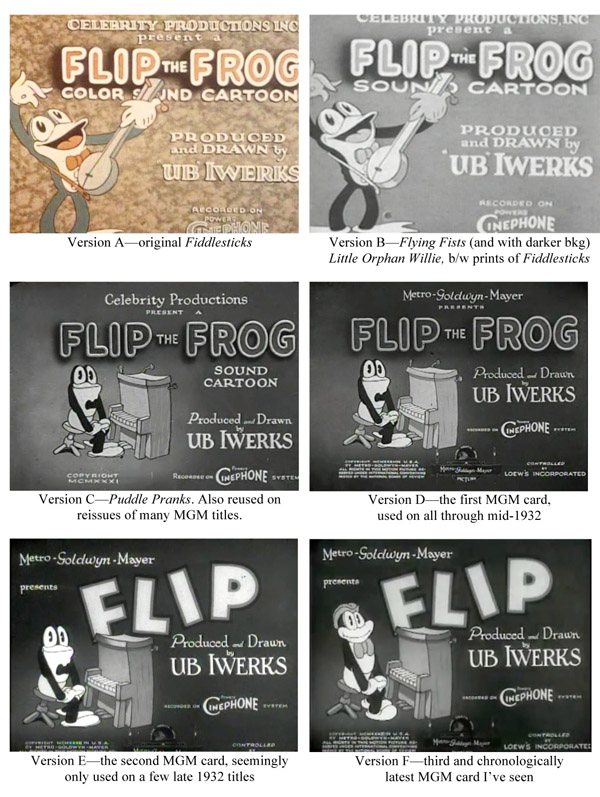
Now, you’d *think* that there would be one ‘master’ for any given film, right? In the case of the Flips, there was a whole basket of materials for some films to sort through, and no elements for others— although most had ‘some’ kind of master material. We looked though all of the Flips that could be pulled at UCLA, and spent an exhaustive time winding through the best material to check for quality and completeness. Here is the list from that evaluation; note that you can usually see what title sequence the print has. I made these notes to determine what to scan and what not to. Note the Flip opening versions match Gerstein’s list above. There’s a few terms here that are notes for the type of material, but I’ve also usually made a note that it truly was that particular element, since at times it wasn’t 100% accurate. (click to enlarge):
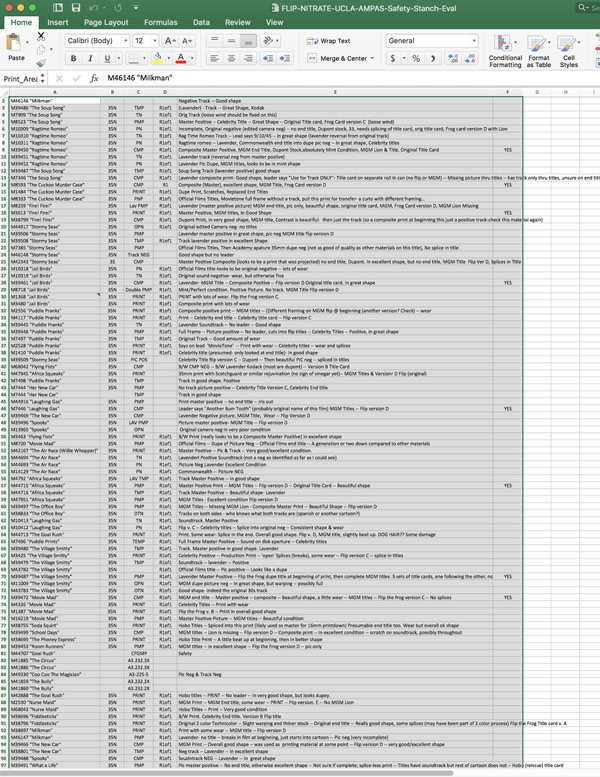
The next stage was to look at the list of *all* the Flips and determine what elements to pull to scan for each. It turned out that many of the films would need multiple elements scanned to get the best versions. Here is the preliminary list of those choices, including checking for other elements and borrowing some elements from collectors and friends to check the quality. Happily, additional 35mm elements have shown up on some of the titles, but we’re still working on getting the very last pieces scanned for the project.
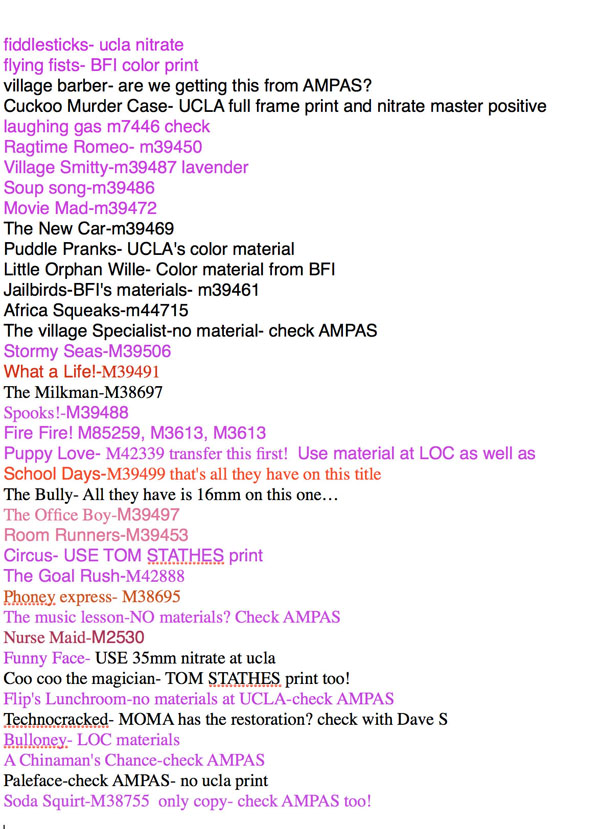
The Flip materials have been scanned at three different facilities, with a majority of the material scanned in Toronto in 4 and 5k. The cleanup of the material has presented (and continues to present) a great challenge in keeping consistency as well as checking for completeness.
Once the scans are done, we organize the scans into folders for each film. Al the different elements that have been scanned for each particular film goes into the folder, making it much easier to find, compare and combine the footage. (click to enlarge)

The funniest thing about getting the material chosen is that often an element looks really good— until you see the even better element. Here is a frame from ’Stormy Seas’ from the master positive:
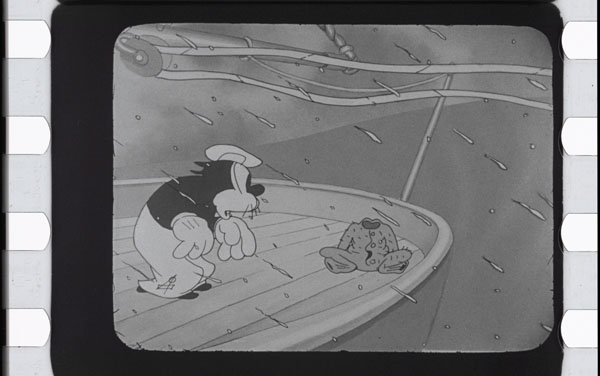
…and the same from from the original camera negative:
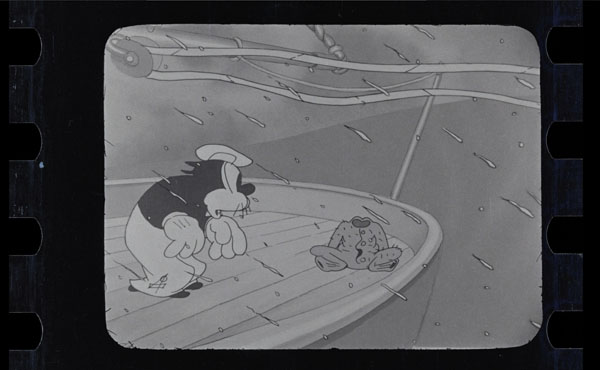
I’ll go into some detail next week on the digital cleanup process and show how it works.
Have a great week everyone!


 Steve Stanchfield is an animator, educator and film archivist. He runs Thunderbean Animation, an animation studio in Ann Arbor, Michigan and has compiled over a dozen archival animation DVD collections devoted to such subjects at Private Snafu, The Little King and the infamous Cubby Bear. Steve is also a professor at the College for Creative Studies in Detroit.
Steve Stanchfield is an animator, educator and film archivist. He runs Thunderbean Animation, an animation studio in Ann Arbor, Michigan and has compiled over a dozen archival animation DVD collections devoted to such subjects at Private Snafu, The Little King and the infamous Cubby Bear. Steve is also a professor at the College for Creative Studies in Detroit.






















I think you need to post those framegrabs from “Stormy Seas” in considerably higher resolution if you want people to see the quality differences. I’m looking at these on a 1080p computer screen and I can’t see any difference.
Wnoa- you left us on a cliffhanger there……
So how much longer until the Flip the Frog Set is ready for Purchase along with Cartoon Commercials Vol.2 and the Blu-Ray Reissue of Stop Motion Marvels ????
Which of those ‘Stormy Seas’ is supposed to be better? I’ve looked at them over and over and I don’t see any appreciable difference.
Top image of ‘Stormy Seas’; brighter.
The version posted doesn’t show the difference too well- sorry about that. Here is a link to the images at 2k:
The master positive:
https://i.imgur.com/Xg5P5nX.jpg
And the Neg:
https://i.imgur.com/LzN3Gb2.jpg
I can see the problems you must face here, and one wonders how many hands these Ub Iwerks cartoons had fallen into before Dave Shepard gained the full video rights. I guess that, to fully understand your dilemma, we’d have to go back that far, to when these were the first bits of animation to be distributed by MGM Studios. Unfortunately, MGM let these slip, whereas they kept ahold of the HAPPY HARMONIES which would have been the next series of cartoons that they would distribute, from a completely different studio. I don’t know the history of the Van Buren cartoons, but I have a copy of your fantastic VAN BUREN TOM AND JERRY double-disk set and it is terrific, despite noticeable (through soundtracks alone) differences in source materials cobbled together to recreate the “perfect” print.
As agonizing as it is, yes, it is worth the wait in hopes that better sources will turn up. Compare your archeological dig with that of a company like Warner Brothers, when it comes to finding the best sources for certain titles and how far they have to travel and hunt down such sources. On the plus side, you have private collectors with whom you can work closely to find the best possible quality, while it might be harder for the larger company to do the same because they feel they would need to own all the varying elements that went into the completed project, which they would if they kept a data base such as you do. When I hear that Warner Brothers (or any video company for that matter) has to rethink reissues and further restoration on a given title, my response (to no one) is “well, why not just go back to the good sources you had for the last release and start from there, continuing the dig in the vaults for bits and pieces, etc…?” However, as you’ve explained, you cannot always hope that the better sources will be available in, say, 35 milimeter, and you cannot pin a 35 mm with a 16 mm, because, even in sound quality, these will differ radically.
Also, when time is taken for further searches, you also have to worry about retaining the quality of the original materials you found and thought were the best and only materials that still exist! Sometimes, the big studios have to go through this as well, as might be happening now with secret projects in the works for us toon fans. When I first caught the FLIP THE FROG cartoons on local TV, they were full of splices, sometimes for censorship reasons. When the classic MGM cartoons came to syndicated TV, with original openings and closings the way we saw ’em in theaters, certain titles (and I think we all know which ones) were distributed with heavy edits, and now, thanks to some TOM AND JERRY classic cartoon collections, including the first fantastic GOLDEN COLLECTION set, we are able to see said titles complete, but complete prints had to be sought out once again; and I wonder how many original negs exist anymore, dating back to when the cartoons were created. One wonders how many nitrate prints exist going back that far, considering the vulnerability of those elements!
As always, good luck to you in further restoration. I also look forward to other projects, like the ANIMATED COMMERCIALS second volume. I see so many turning up on You Tube; the cereal commercials alone would make up a single volume, believe me. I haven’t seen the classic GOOD ‘N’ PLENTY candy ads for years. Do they still exist? The familiar TV DAYS site had been trying to gather all kinds of classic commercials for decades now, so I really wonder how easy it is to find these anymore. I’d love to hear about where you have to go to hunt down a classic TV commercial that we all remember and most TV stations discarded once the run on the air had finished. When did such collecting actually begin and how many hands did such ads go through before special care was taken to preserve them? I hope you can find all these answers and these materials. I thoroughly enjoy the two blu-ray editions of the MID-CENTURY MODERN volumes. I know that all other such volumes will not go out the door until they look and sound as good as these!
Nice post, Steve…seems like this project will take longer….(???) How about Grotesqueries, Popeye in color and some other ones pre-ordered?…Would like to know.
Great post! Thanks for the details on putting the set together!
However, I still don’t see much difference between the two stills even at the higher resolution! I put them on different pages and clicked back and forth between them and couldn’t see any difference whatsoever, except for one super-slight blemish on one. Otherwise, the blacks were equally black, the whites equally white, and all the lines equally sharp. Good luck choosing between the two! 😉
The original neg is just a LITTLE bit sharper in image quality than the fine-grain.
The second frame is slightly sharper. There is a mild blur on the line art on the first one. I am thankful for this kind of attention to detail on the Ub Iwerks films!
I love articles like this! The behind-the-scenes stuff gets me excited for the inevitable release. Looking forward to seeing Flip when it’s finished. I also can’t wait to see the new special discs (plus the finished ones I ordered a while back)!
I love behind the scenes articles like this one! It was so fascinating to see the details of the process. I am very excited for the Flip the Frog set. I’m glad the delay has led to even better materials to scan.
Hi Steve,
Does this mean that all of the Fiip Color cartoons will be presented in Color for the first time.?
As always I am so excited for and eagerly await the “Lou Bunin / Alice in Wonderland” set – I look forward to seeing the final results and an OFFICIAL release!